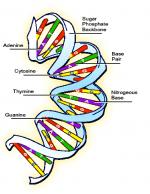|
This section contains 324 words (approx. 2 pages at 300 words per page) |
Restriction enzymes selectively cut DNA. The sites at which restriction enzymes act are called cutting sites or restriction sites. The first restriction enzyme, isolated from the bacterium Haemophilus influenzae in 1968, was called HindIII (restriction enzymes names often include a Roman numeral designation). Since then over 900 restriction enzymes have been discovered.
These enzymes, also called restriction endonucleases, cut DNA into smaller pieces in a very specific fashion. A restriction enzyme usually recognizes a specific sequence of bases in the DNA. Different restriction enzymes recognize different sequences and they are specific for different sequences. Judicious selection of enzymes and comparison of the patterns of DNA fragments can provide much information about the sequence of the DNA.
Most cutting sites are a four, six, or eight-base palindromic sequence (i.e., the bases along one DNA strand and their complimentary bases on the other strand). This site is called the recognition sequence. Most enzymes cut the DNA at the recognition sequence, so the recognition sequence and cutting site are identical. A few enzymes cut the DNA nearby, but not at, the recognition site. This distinction can become important if the cut DNA is to be used in a recombinant DNA construction. Different endonucleases produce different sets of cuts, but one endonuclease will always cut a particular base sequence the same way, no matter what DNA molecule it is acting on.
Not all cutting sites are cut symmetrically, leaving blunt ends on both the cut strands. For example, the enzyme EcoRI (derived from Escherichia coli RY13) cuts at the recognition site to produce two DNA fragments, each with a protruding base at one end. These "sticky ends" are prone to bind with another unpaired length of DNA having a complimentary base at its sticky end. This phenomenon allows the recombination of DNA molecules (i.e., DNA molecules composed of DNA from different sources). The ability to create recombinant DNA spawned the multi-billion dollar biotechnology industry.
|
This section contains 324 words (approx. 2 pages at 300 words per page) |


